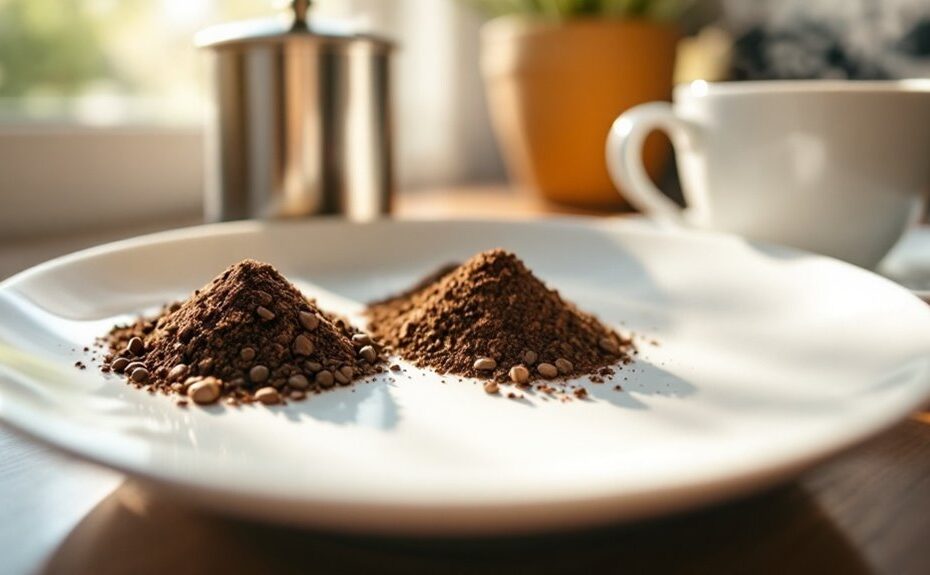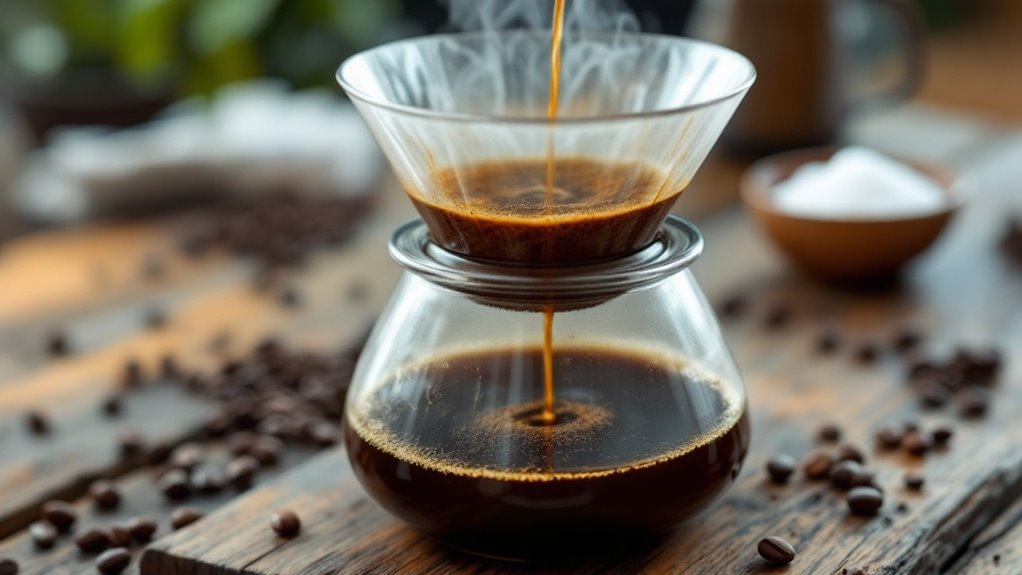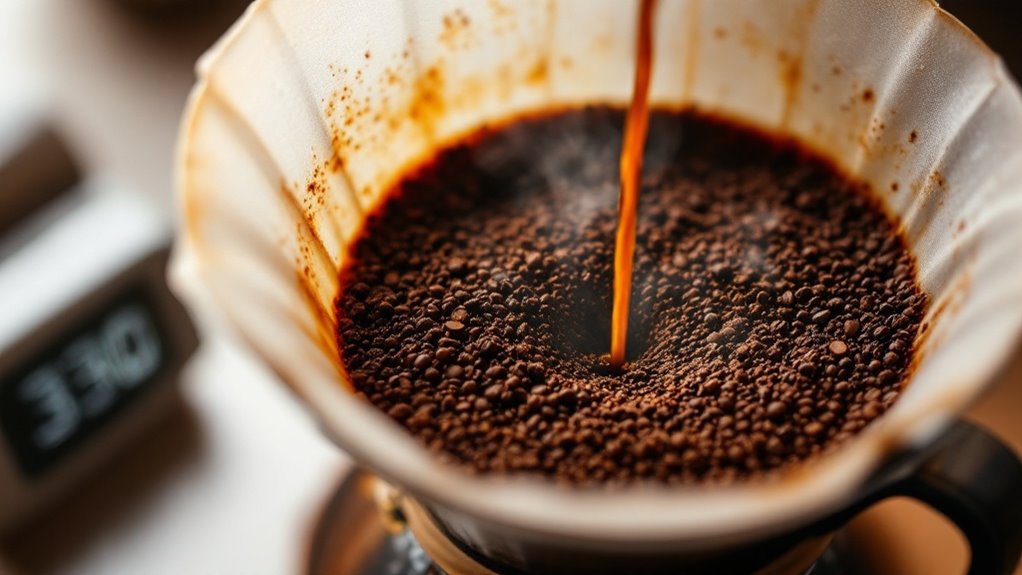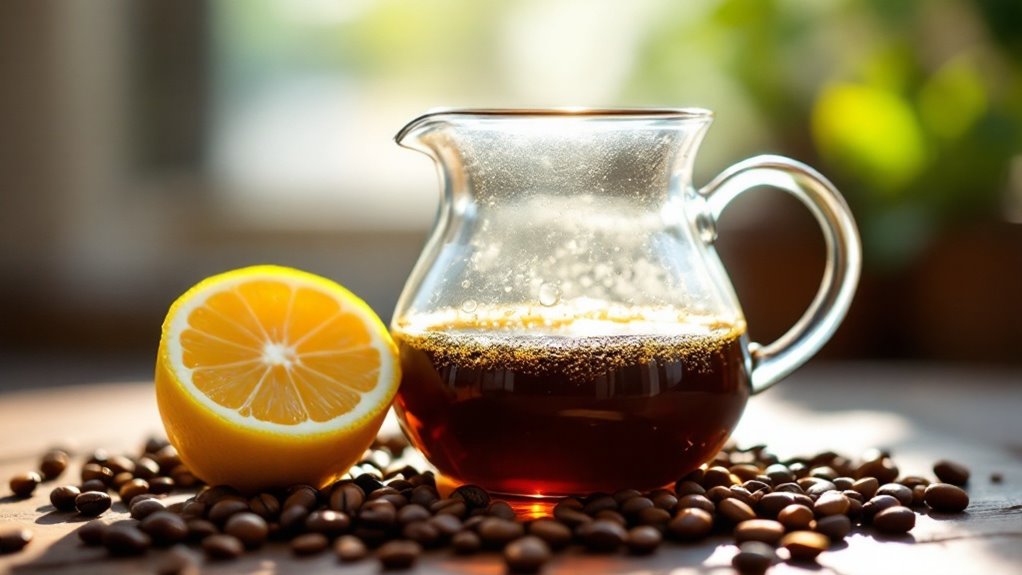







When you grind coffee, the size of the particles directly shapes the flavor in your cup. Finer grinds expose more surface area, speeding up extraction and risking bitterness, while coarser grinds slow it down, potentially leaving you with a sour or weak brew. But it's not just about size—uniformity matters too, as inconsistent grinds can throw off the balance of acidity, sweetness, and bitterness. The real question is, how do you find the perfect grind for your brewing method? The answer lies in understanding the interplay between grind size, extraction, and the tools you use.
Key Takeaways
- Grind size determines extraction efficiency: finer grinds extract faster, risking bitterness; coarser grinds extract slower, risking sourness.
- Uniform grind size ensures balanced extraction, highlighting acidity, sweetness, and bitterness without over- or under-extraction.
- Brewing method dictates grind size: fine for espresso, medium for pour-over, and coarse for French press or cold brew.
- Inconsistent grind sizes lead to uneven extraction, causing both bitterness (over-extraction) and sourness (under-extraction) in the same brew.
- Burr grinders produce consistent grind sizes, optimizing flavor clarity, while blade grinders create uneven particles, muddying flavor profiles.
Why Coffee Needs to Be Ground
Grinding coffee is a critical step in releasing its full flavor potential, as it directly impacts the extraction process during brewing. When you grind coffee beans, you increase their surface area exponentially, allowing water to interact more effectively with the soluble compounds locked inside. Whole beans, on the other hand, expose only a fraction of their surface to water, resulting in weak, under-extracted coffee that lacks depth and complexity. By breaking the beans into smaller particles, you create pathways for water to penetrate and dissolve the desirable flavors, aromas, and oils.
Freshly ground coffee is essential because pre-ground beans lose their volatile compounds rapidly due to oxidation, leading to stale, flat flavors. When you grind your beans just before brewing, you preserve the delicate aromatics and guarantee a vibrant, nuanced cup. The grind size also determines how efficiently water extracts these compounds—too coarse, and you'll under-extract; too fine, and you risk over-extraction. Proper grinding secures a balanced extraction, highlighting the coffee's acidity, sweetness, and bitterness in harmony. Without grinding, you'd miss the full spectrum of flavors that make coffee a rich, satisfying experience.
How Grind Size Affects Extraction
The size of your coffee grind plays a pivotal role in determining how effectively water extracts flavors during brewing. Finer grinds increase the surface area of coffee particles, allowing water to dissolve soluble compounds more rapidly. This accelerates extraction, often resulting in higher concentrations of flavors, but risks over-extraction if brewing time isn't adjusted. Over-extraction pulls bitter, astringent compounds, overwhelming the desired balance. Conversely, coarser grinds reduce surface area, slowing extraction. This can lead to under-extraction, where insufficient compounds dissolve, producing weak, sour, or flat flavors. Ideal extraction hinges on matching grind size to brewing time. For example, espresso requires fine grinds (around 200-300 microns) and short brewing times (25-30 seconds) to achieve intense, balanced flavors. Coarser grinds (500-800 microns), suited for methods like French press, demand longer brewing times (4-5 minutes) to extract enough compounds without bitterness. The interplay between grind size, surface area, and brewing time dictates the final flavor profile. Precision in grind size guarantees you extract the right balance of acids, sugars, and oils, avoiding both over-extraction's harshness and under-extraction's dullness.
Choosing the Right Grind for Brewing Methods
Selecting the appropriate grind size for your brewing method is essential to revealing the full potential of your coffee. For espresso, you'll need a fine grind size of approximately 0.3mm to guarantee proper extraction under 9-10 bars of pressure within 20-30 seconds, yielding a concentrated and balanced shot. French press brewing methods, on the other hand, require a coarse grind size of around 1.5mm to prevent overextraction during the 4-minute immersion process, producing a full-bodied and robust cup. Pour-over methods like the V60 demand a medium grind size of about 0.75mm to enhance water flow and extraction time, resulting in a clean, nuanced flavor profile. For cold brew, an extra-coarse grind size of 1.5mm is ideal to accommodate the extended 12-24 hour steeping period, securing a smooth, low-acidity brew. Turkish coffee, however, necessitates an ultra-fine grind size of 0.1mm to achieve the characteristic thick, sludgy texture and intense flavor during its short, high-temperature brewing. Matching your coffee grounds to the specific brewing method guarantees peak extraction and flavor clarity.
Factors Influencing Grind Size Selection
Considering the brewing method, grind size selection hinges on achieving ideal extraction by balancing water flow, contact time, and particle uniformity. For espresso, a fine grind size of 0.3mm guarantees peak resistance to high-pressure water flow, typically at 9 bars, while maintaining a 25-30 second extraction window. Conversely, a French press requires a coarse grind size of 1.5mm to prevent over-extraction during its 4-minute brew time, as larger particles reduce surface area and slow water penetration. Water temperature also plays a critical role; a range of 195-205°F (90-96°C) is ideal for most brewing methods, but finer grinds demand precise control to avoid scorching and bitterness. Darker roasts, being more soluble, often benefit from a slightly coarser grind to mitigate over-extraction, while older beans may require a finer grind to compensate for reduced solubility. Uniformity in grind size, influenced by grinder quality, secures consistent extraction, preventing under-extracted or over-extracted flavors. By aligning grind size with brewing method, water temperature, and bean characteristics, you achieve a balanced and flavorful cup.
Burr vs. Blade Grinders: Impact on Flavor
When comparing burr and blade grinders, you'll find that burr grinders produce a uniform grind size, typically within a 200-400 micron range, ensuring balanced extraction and enhanced flavor clarity. Blade grinders, however, create inconsistent particle sizes, ranging from 100 to 800 microns, leading to uneven extraction and a muddled flavor profile. Additionally, burr grinders allow you to adjust grind settings with 0.1 mm precision, optimizing extraction for specific brewing methods, while blade grinders generate heat that can degrade aromatic compounds by up to 15%.
Uniformity Enhances Flavor
The uniformity of coffee grind size plays a critical role in achieving ideal flavor extraction, with burr grinders outperforming blade grinders in this regard. Burr grinders produce uniform particle sizes, typically within a 200-500 micron range, ensuring consistent extraction and balanced flavor. This precision minimizes the risk of over-extracting fine particles, which can lead to bitterness, and under-extracting coarse particles, which can cause sourness. In contrast, blade grinders create uneven grinds, resulting in a mix of fines and boulders that disrupt extraction uniformity.
Burr grinders also allow for precise grind size adjustments, enabling you to tailor extraction rates to specific brewing methods. For example, a medium grind of 600-800 microns suits drip coffee, while a fine grind of 300-400 microns works best for espresso. This control enhances flavor clarity and complexity. Additionally, burr grinders operate at lower temperatures, preserving delicate coffee oils and aromas that contribute to a richer sensory experience. The consistent grind size from burr grinders improves brew clarity and mouthfeel, avoiding the muddy or inconsistent textures often produced by blade grinders. Uniform particle sizes are essential for achieving a balanced, flavorful cup.
Blade Grinders: Inconsistent Results
Blade grinders chop coffee beans with a spinning blade, creating a mix of fine and coarse particles that range widely in size, often spanning 100 to 1000 microns. This inconsistency in grind size leads to uneven extraction during brewing, as fine particles over-extract, releasing bitter compounds, while coarse particles under-extract, resulting in weak, underdeveloped flavors. The lack of uniformity in a blade grinder's output makes it unsuitable for methods requiring precise grind sizes, such as espresso or pour-over, where particle distribution directly impacts flavor balance. Additionally, the rapid spinning of the blade generates heat, which can degrade volatile aromatic compounds and coffee oils, further diminishing flavor quality. Without adjustable settings, you can't control the grind size, making it difficult to tailor the grind to specific brewing techniques. The resulting brew often exhibits a muddy mouthfeel and an unbalanced flavor profile, with both bitterness and sourness present. For ideal extraction and flavor clarity, the inconsistency of a blade grinder's grind size poses a significant limitation, particularly when compared to more precise grinding methods.
Burr Grinders: Precision Grinding
Burr grinders achieve superior precision by crushing coffee beans between two abrasive surfaces, producing particle sizes that typically range within a narrow 200-300 micron window. This uniformity in grind size guarantees consistent extraction, as each particle interacts with water at the same rate, balancing acidity, sweetness, and bitterness. Unlike blade grinders, which create a mix of fine and coarse particles, a burr grinder minimizes the risk of over-extracted fines (bitter) and under-extracted boulders (sour). You can adjust the grind size on a burr grinder to match specific brewing methods, such as a fine 200-micron grind for espresso or a coarser 800-micron grind for French press. This precision allows you to optimize flavor profiles and extraction efficiency, making burr grinders essential for specialty coffee brewing. By investing in a burr grinder, you secure that your coffee's particle size distribution remains tight, enhancing both consistency and quality. The result is a cup that reflects the intended flavor notes of the beans, free from the imbalances caused by uneven grind sizes.
Tips for Perfecting Coffee Grind Size at Home
While achieving the perfect coffee grind size at home may seem intimidating, it's entirely manageable with the right tools and techniques. Start by investing in a burr grinder, which guarantees uniform grind size by crushing beans between two abrasive surfaces. Blade grinders, in contrast, produce uneven particles, leading to inconsistent extraction and flavor. Match your grind size to your brewing method: use a coarse grind (similar to sea salt) for French press, a medium grind (like granulated sugar) for drip coffee, and a fine grind (resembling table salt) for espresso. These adjustments enhance extraction rates and flavor profiles.
Consider your coffee's roast level when setting your grinder. Darker roasts benefit from slightly coarser grinds to prevent over-extraction, while lighter roasts may require finer grinds for balanced extraction. Clean your grinder regularly to avoid stale coffee residue, which can alter grind consistency and flavor. Finally, experiment with small grind size adjustments—0.1 to 0.2 mm increments—and conduct taste tests to fine-tune your brew. This iterative approach guarantees you achieve the ideal flavor balance for your preferred brewing method.
Disclosure: As an Amazon Associate, I earn from qualifying purchases.




